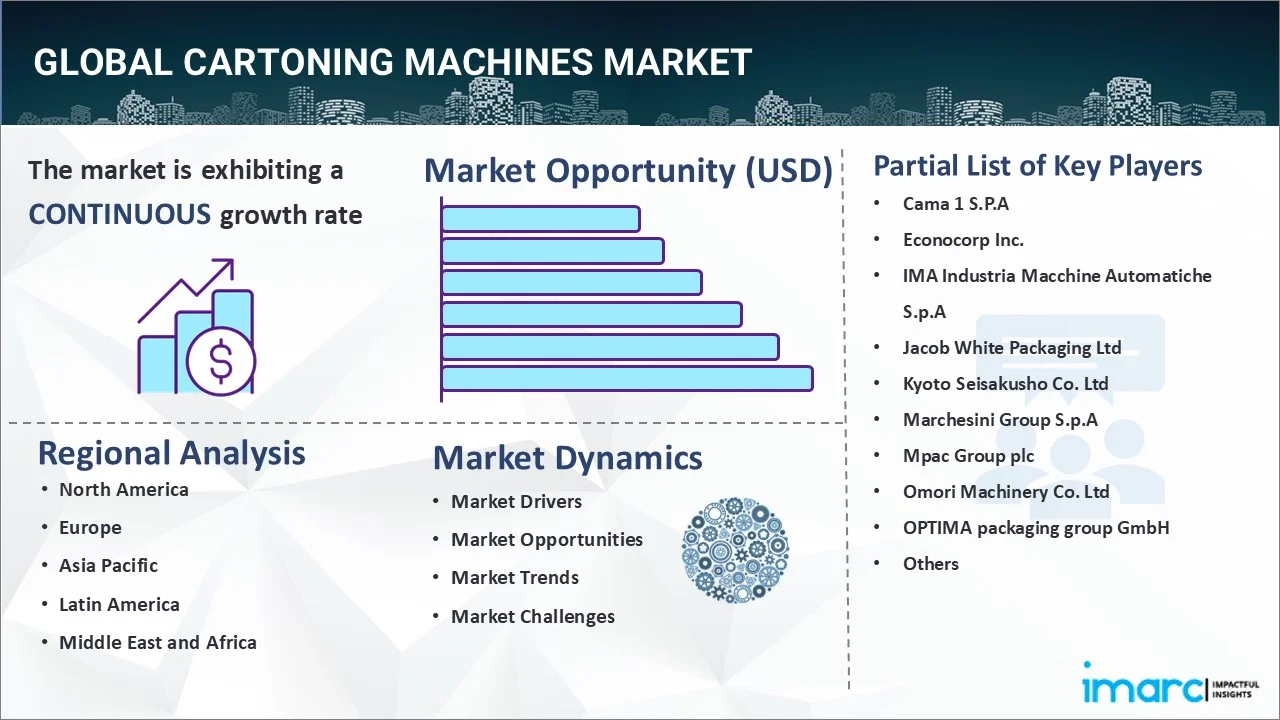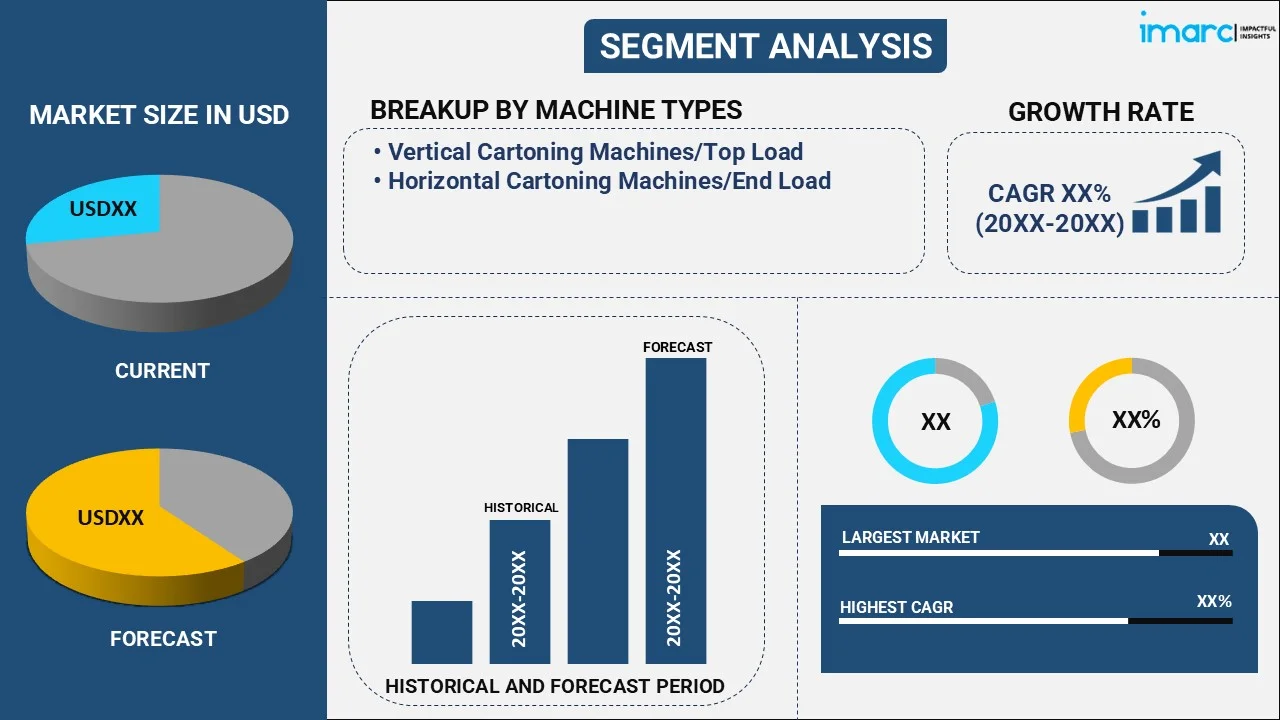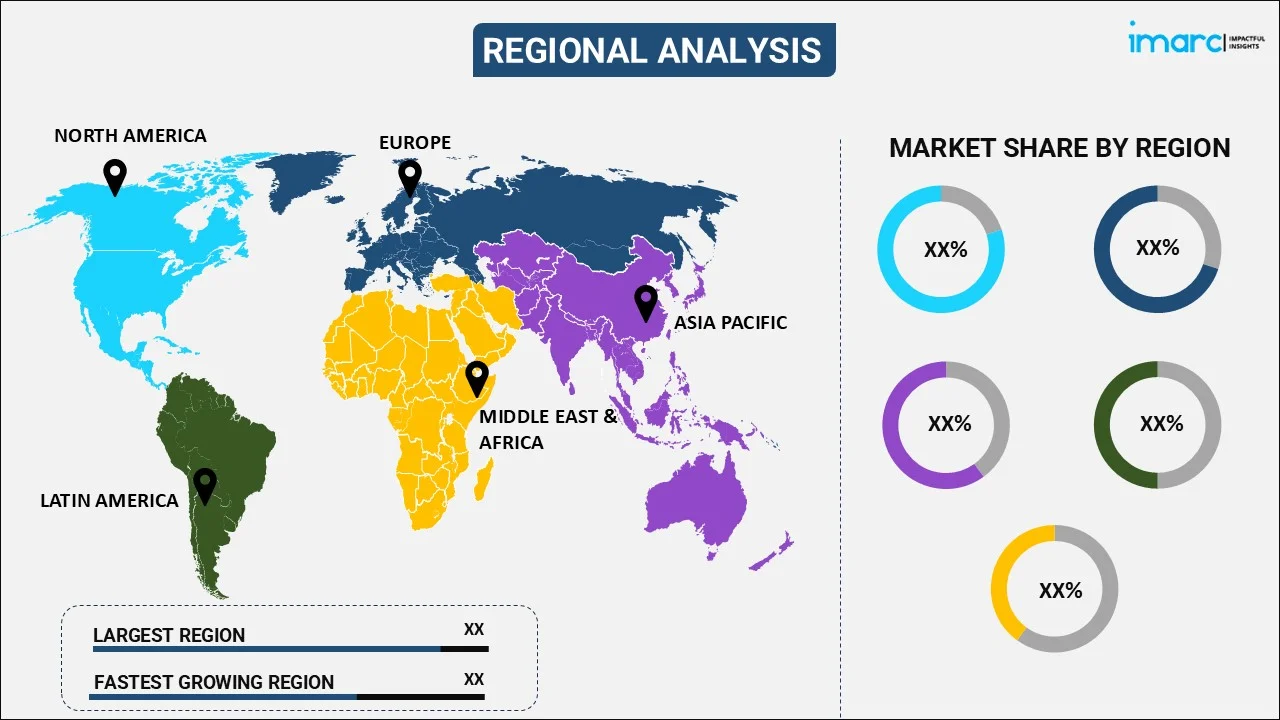
Cartoning Machines Market Report by Machine Type (Vertical Cartoning Machines/Top Load, Horizontal Cartoning Machines/End Load), Application (Food and Beverage, Consumer Goods, Healthcare Pharmaceutical, and Others), and Region 2025-2033
Market Overview:
The global cartoning machines market size reached USD 4.6 Billion in 2024. Looking forward, IMARC Group expects the market to reach USD 6.6 Billion by 2033, exhibiting a growth rate (CAGR) of 3.85% during 2025-2033. The increasing product demand in the food and beverage (F&B) industry, significant technological advancements, and extensive research and development (R&D) activities represent some of the key factors driving the market. At present, Asia Pacific holds the largest market share, driven by rapid growth in the consumer goods industry.
|
Report Attribute
|
Key Statistics
|
|---|---|
|
Base Year
|
2024 |
|
Forecast Years
|
2025-2033
|
|
Historical Years
|
2019-2024
|
| Market Size in 2024 | USD 4.6 Billion |
| Market Forecast in 2033 | USD 6.6 Billion |
| Market Growth Rate (2025-2033) | 3.85% |
A cartoning machine is an automated packaging equipment used to pack products into cartons or boxes. It commonly forms erect, closed, folded, side-seamed, and sealed cartons. It consists of belt, or bucket conveyors, loading, printing, vision inspection, and control systems. A cartoning machine is widely used for forming cartons and storing products inside the carton, either manually or automatically, and then folding or sealing the carton with glue for the further transportation process. It is a cost-effective, reliable, and essential piece of equipment for many industries, as it improves packaging efficiency and reduces labor costs. It also helps to improve product quality, increase productivity, and ensures enhanced quality and accuracy of the packaging process. As a result, cartoning machines find extensive applications across the food and beverage (F&B), healthcare, and e-commerce industries.

Cartoning Machines Market Trends:
Increasing Adoption in Different Industries
The increasing product demand in the F&B industry across the globe is one of the key factors driving the cartoning machines market growth. Cartoning machines are used for packaging a wide range of products, such as cereal boxes, frozen meals, snack bars, and juice boxes. Additionally, the significant growth in the e-commerce industry is favoring the product demand. These machines are used for packaging products for shipping to customers, ensuring that products reach their destination in good condition. In line with this, the widespread product utilization in the transportation and logistics industry for shipping, transporting, and distributing goods is creating growth opportunities for the key market participants to capitalize on. Moreover, the widespread product utilization in the cosmetics industry to package products such as lipstick, mascara, and skin care products is propelling the adoption of cartooning machines.
Product Innovations
The development of automated packaging cartoning machines that are used for automatically adding protective materials, and sealing the cartons for shipping which helps to reduce labor costs and improve the speed and efficiency of the process, is providing an impetus to the market potential. Furthermore, the increasing demand for customized packaging that helps key players to package a wide range of products for shipping, including fragile items that require additional protection, is creating a positive outlook for the market. Other factors, including the introduction of environmentally friendly packaging, and increasing inclination toward reducing time and ensuring quality control, are opportunistic for the cartoning machines market growth.
Increasing Demand for High-Speed and Flexible Machines
The market is witnessing a growing demand for machines that can operate at high speeds and offer flexibility to accommodate a variety of packaging formats. As manufacturers strive to improve their production efficiency and reduce costs, there is a strong preference for machines that can handle large volumes of products while maintaining accuracy and precision. This trend has led to the development of advanced cartoning machines with features such as modular designs, quick changeovers, and the ability to handle complex packaging formats.
Key Market Segmentation:
IMARC Group provides an analysis of the key trends in each segment of the global cartoning machines market report, along with forecasts at the global, regional and country levels for 2025-2033. Our report has categorized the market based on machine type, and application.
Machine Type Insights:

- Vertical Cartoning Machines/Top Load
- Horizontal Cartoning Machines/End Load
The report has provided a detailed breakup and analysis of the cartoning machines market based on the machine type. This includes vertical cartoning machines/top load and horizontal cartoning machines/end load. According to the report, horizontal cartoning machines/end load represented the largest segment.
Application Insights:
- Food and Beverage
- Consumer Goods
- Healthcare Pharmaceutical
- Others
The report has provided a detailed breakup and analysis of the cartoning machines market based on the application. This includes food and beverage, consumer goods, healthcare pharmaceutical and others. According to the report, food and beverage represented the largest segment.
Regional Insights:

- North America
- United States
- Canada
- Europe
- Germany
- France
- United Kingdom
- Italy
- Spain
- Others
- Asia Pacific
- China
- Japan
- India
- South Korea
- Australia
- Indonesia
- Others
- Latin America
- Brazil
- Mexico
- Others
- Middle East and Africa
The report has also provided a comprehensive analysis of all the major regional markets, which include North America (the United States and Canada); Europe (Germany, France, the United Kingdom, Italy, Spain, and others); Asia Pacific (China, Japan, India, South Korea, Australia, Indonesia, and others); Latin America (Brazil, Mexico, and others); and the Middle East and Africa. According to the report, Asia Pacific was the largest market for cartoning machines. Some of the factors driving the Asia Pacific cartoning machines market included the introduction of environmentally friendly packaging, significant technological advancements, and increasing expenditure capacities.
Competitive Landscape:
The report has also provided a comprehensive analysis of the competitive landscape in the global market. Competitive analysis such as market structure, cartoning machines market share by key players, player positioning, top winning strategies, competitive dashboard, and company evaluation quadrant has been covered in the report. Also, detailed profiles of all major companies have been provided. Some of the companies covered include:
- Cama 1 S.P.A
- Econocorp Inc.
- IMA Industria Macchine Automatiche S.p.A
- Jacob White Packaging Ltd
- Kyoto Seisakusho Co. Ltd
- Marchesini Group S.p.A
- Mpac Group plc
- Omori Machinery Co. Ltd
- OPTIMA packaging group GmbH
- Pakona Engineer
- Pmr Packaging Inc.
- Rovema GmbH
- Shibuya Corporation
Kindly note that this only represents a partial list of companies, and the complete list has been provided in the report.
Cartoning Machines Market Report Scope:
| Report Features | Details |
|---|---|
| Base Year of the Analysis | 2024 |
| Historical Period | 2019-2024 |
| Forecast Period | 2025-2033 |
| Units | Billion USD |
| Scope of the Report | Exploration of Historical and Forecast Trends, Industry Catalysts and Challenges, Segment-Wise Historical and Predictive Market Assessment:
|
| Machine Types Covered | Vertical Cartoning Machines/Top Load, Horizontal Cartoning Machines/End Load |
| Applications Covered | Food and Beverage, Consumer Goods, Healthcare Pharmaceutical, Others |
| Regions Covered | Asia Pacific, Europe, North America, Latin America, Middle East and Africa |
| Countries Covered | United States, Canada, Germany, France, United Kingdom, Italy, Spain, China, Japan, India, South Korea, Australia, Indonesia, Brazil, Mexico |
| Companies Covered | Cama 1 S.P.A, Econocorp Inc., IMA Industria Macchine Automatiche S.p.A, Jacob White Packaging Ltd, Kyoto Seisakusho Co. Ltd, Marchesini Group S.p.A, Mpac Group plc, Omori Machinery Co. Ltd, OPTIMA packaging group GmbH, Pakona Engineer, Pmr Packaging Inc., Rovema GmbH, Shibuya Corporation, etc. |
| Customization Scope | 10% Free Customization |
| Post-Sale Analyst Support | 10-12 Weeks |
| Delivery Format | PDF and Excel through Email (We can also provide the editable version of the report in PPT/Word format on special request) |
Key Questions Answered in This Report:
- How has the global cartoning machines market performed so far, and how will it perform in the coming years?
- What are the drivers, restraints, and opportunities in the global cartoning machines market?
- What is the impact of each driver, restraint, and opportunity on the global cartoning machines market?
- What are the key regional markets?
- Which countries represent the most attractive cartoning machines market?
- What is the breakup of the market based on the machine type?
- Which is the most attractive machine type in the cartoning machines market?
- What is the breakup of the market based on the application?
- Which is the most attractive application in the cartoning machines market?
- What is the competitive structure of the global cartoning machines market?
- Who are the key players/companies in the global cartoning machines market?
Key Benefits for Stakeholders:
- IMARC’s report offers a comprehensive quantitative analysis of various market segments, historical and current market trends, cartoning machines market forecast, and dynamics of the market from 2019-2033.
- The research study provides the latest information on the market drivers, challenges, and opportunities in the global cartoning machines market.
- The study maps the leading, as well as the fastest-growing, regional markets. It further enables stakeholders to identify the key country-level markets within each region.
- Porter's five forces analysis assist stakeholders in assessing the impact of new entrants, competitive rivalry, supplier power, buyer power, and the threat of substitution. It helps stakeholders to analyze the level of competition within the cartoning machines industry and its attractiveness.
- Competitive landscape allows stakeholders to understand their competitive environment and provides an insight into the current positions of key players in the market.
Need more help?
- Speak to our experienced analysts for insights on the current market scenarios.
- Include additional segments and countries to customize the report as per your requirement.
- Gain an unparalleled competitive advantage in your domain by understanding how to utilize the report and positively impacting your operations and revenue.
- For further assistance, please connect with our analysts.
 Inquire Before Buying
Inquire Before Buying
 Speak to an Analyst
Speak to an Analyst
 Request Brochure
Request Brochure
 Request Customization
Request Customization




.webp)




.webp)












